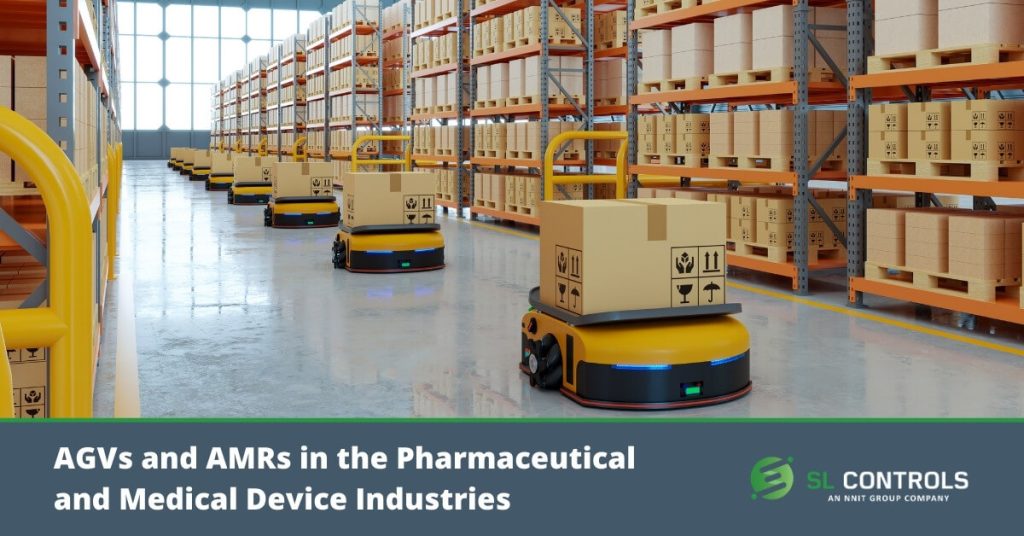Automated Guided Vehicles (AGVs) and Autonomous Mobile Robots (AMRs) are technologies that are transforming the pharmaceutical and medical device industries. When implemented properly, they can help manufacturers in the life sciences sector overcome some of the most difficult of today’s challenges, as well as improving productivity, efficiency, and quality.
Both technologies are similar as they are both material handling solutions that don’t require human intervention or involvement. In this blog, we’ll look at the differences between AGVs and AMRs, as well as suitable applications for these technologies in the life sciences sector and the benefits for pharmaceutical and medical device manufacturers.
What are AGVs?
AGVs are the older of the two types of material-handling robots as they date back about 70 years. Recent advances in technologies have now made AGVs a viable solution for many pharmaceutical and medical device production applications.
In brief, AGVs combine software and hardware systems to navigate and perform in predefined areas via fixed routes.
What are AMRs?
AMRs are also material-handling robots but, unlike AGVs, they don’t have to follow predefined routes. Instead, AMRs navigate autonomously using onboard sensors, cameras, and software. In other words, they can dynamically plan their route and avoid obstacles in real time.
Applications for AGVs and AMRs in the Pharmaceutical and Medical Device Industries
AMRs are a more recent technology, but there are applications for both AMRs and AGVs in the pharmaceutical and medical device industries. Those applications include:
- Transferring raw materials from storage and facility intake areas to the manufacturing line.
- Transferring product batches between manufacturing process stages.
- Transferring manufactured products for storage or shipping, or to assembly or packing stations.
- Transferring packaging materials to packing stations on the production line.
- Transferring waste material to disposal, recycling, and reprocessing areas.
- Storing and retrieving products in warehouses.
- Conducting various operations in clean room environments to reduce the need for human involvement and, as a result, lower the risk of contamination.
- Hazardous material handling.
The Benefits of AGVs and AMRs
Operators currently perform the tasks that AGVs and AMRs can automate in pharmaceutical and medical device manufacturing facilities. Automating these tasks brings a range of benefits:
- Efficiency improvements through enhanced productivity and greater workflow consistency. For example, AGVs can eliminate delays in getting raw materials to the production line.
- Various labor benefits, including being able to assign operators to more value-added tasks and reducing the labor that is required.
- Consistent performance as AGVs and AMRs don’t get tired, distracted, or sick. Instead, they perform tasks repetitively and consistently. Even low batteries don’t have to impact performance as systems can be set up in fleets, where an AGV or AMR with a low battery can return to a charging station while another, fully charged unit, takes its place.
- Speeds up production in a variety of ways, depending on how the AGVs or AMRs are deployed. For example, AGVs/AMRs can ensure raw materials are transferred to the production line efficiently and without delay.
- Optimises material flow throughout the manufacturing facility.
- Reduces human error in areas like inventory management and material transportation.
- Enhances traceability and overall process improvement, particularly if AGVs or AMRs are integrated with MES, ERP, and other business process, production, warehouse, and supply chain management systems.
- Enhances compliance with sensors logging data about the materials being transported.
- Enhances production oversight by using the data logged by the sensors on AGVs and AMRs.
- Improves worker ergonomics and safety as AGVs and AMRs reduce the need for manual handling in pharmaceutical and medical device production facilities.
- Improves hygiene and contamination control, especially in cleanroom environments where AGVs can reduce the need for human operators.
Humans and Machines Working Together
The future of pharmaceutical and medical device manufacturing facilities is one where humans and machines work together, with machines handling repetitive and monotonous tasks to leave engineers, technicians, and operators free for more demanding, challenging, and value-adding tasks. AGVs and AMRs are essential components of the factory of the future. Their importance will only increase as technologies develop and they become more integrated into the production environment.

